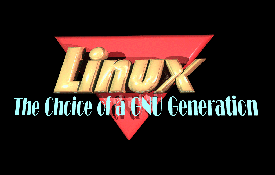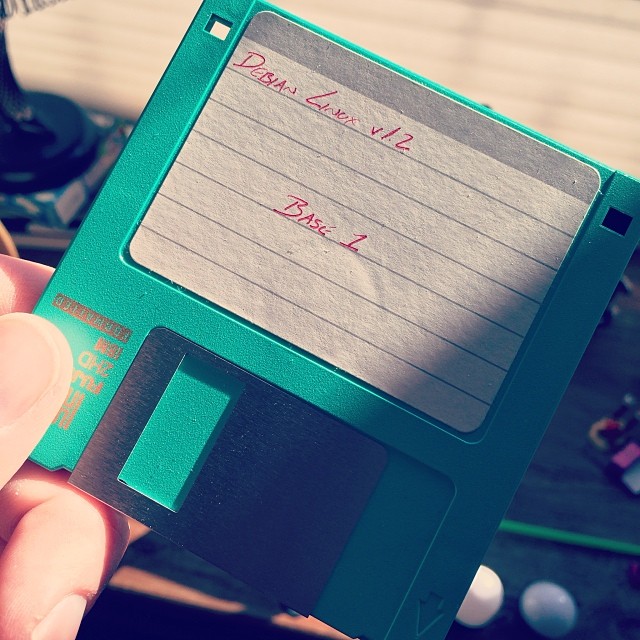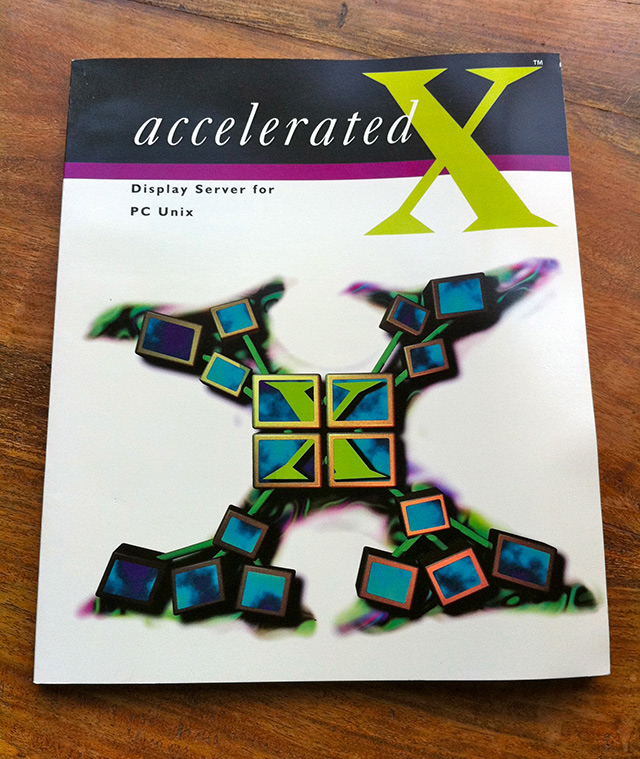 I stumbled upon a discussion of GNU/Linux on the desktop on Reddit recently, with someone predicting that “next year” will be the year of Linux on the desktop (with tongue-in-cheek and as it ever was). This got me thinking about the one time that I ever ran Linux as my primary desktop OS, and I thought I’d write a little about it.
I stumbled upon a discussion of GNU/Linux on the desktop on Reddit recently, with someone predicting that “next year” will be the year of Linux on the desktop (with tongue-in-cheek and as it ever was). This got me thinking about the one time that I ever ran Linux as my primary desktop OS, and I thought I’d write a little about it.
I’ll set the scene. After graduating college in December 1995, I immediately found employment as a systems administrator of a LANtastic network of Windows 3.1 machines at an engineering firm in southern Virginia. I was living alone (the only year of my life I ever did so) in an apartment in lovely Williamsburg, VA. It’s good that I was alone, as the work hours were occasionally late and the Playstation had just launched, so I spent an inordinate amount of time in the wee hours on that console. Or down at the delis (the Williamsburg equivalent of pubs). Or anything other than cleaning what eventually became a shockingly wrecked bachelor pad. Ahh, the halcyon days.
Anyway, I had an eCesys 486 66MHz PC that I purchased in 1994 to run NeXTSTEP for Intel during college. After a while I installed Windows 95 beta on it and then upgraded the motherboard and CPU to an AMD 486 DX4120. Shortly thereafter, I bumped the CPU once again, this time to an AMD 5×86 160MHz. Most of the time I spent on that PC while living in that apartment (1996) I was running Windows 95, playing Phantasmagoria and Zork Zero with my girlfriend, and exploring the new World Wide Web via dial-up PPP. Then one day, late in the year, it struck me to try out desktop Linux.
 In the labs in college we used SunOS on SPARCstations and HP/UX on HP workstations (there were even some Tatung Sun clones about), and as I mentioned, I ran NEXTSTEP for a while at home, so Linux was a comfortable notion. After looking around, I decided to go with Debian Linux — their latest development build (v1.2 “Rex”). And it wasn’t a download, it was an order for media shipped by mail. And that media wasn’t a CD, but around 15 3.5-inch HD floppy disks. It arrived, I installed.
In the labs in college we used SunOS on SPARCstations and HP/UX on HP workstations (there were even some Tatung Sun clones about), and as I mentioned, I ran NEXTSTEP for a while at home, so Linux was a comfortable notion. After looking around, I decided to go with Debian Linux — their latest development build (v1.2 “Rex”). And it wasn’t a download, it was an order for media shipped by mail. And that media wasn’t a CD, but around 15 3.5-inch HD floppy disks. It arrived, I installed.
Or tried. It turns out there was a path issue in the install script, which I discovered in the newsgroups, and so I ended up having to edit a script on one of the floppies, correcting a path, in order to get Debian running. The whole process took every night of a week, plus some of the weekend. It was painful. But, I was finally greeted with a lovely X-Windows desktop.
In greyscale. You see, the video card I was using was a Hercules Dynamite Power 2MB VLB featuring a Tseng ET4000/W32p, the fastest DOS-mode chipset available at the time. I chose this card through a desire to wring the most graphic performance out of DOS-based scenedemos of the day. But, when it came to XFree86, well, the support was minimal.
 Faced with this dilemma, I did some research and found that a $99 commercial X server from Xi Graphics called Accelerated X offered higher performance than XFree86 and supported my video card fully. So, I ordered, it arrived (on floppy), I installed, and it was 16-bit color and the lovely Windowmaker window manager that I began to interact with daily. The whole interface looked great and felt very smooth.
Faced with this dilemma, I did some research and found that a $99 commercial X server from Xi Graphics called Accelerated X offered higher performance than XFree86 and supported my video card fully. So, I ordered, it arrived (on floppy), I installed, and it was 16-bit color and the lovely Windowmaker window manager that I began to interact with daily. The whole interface looked great and felt very smooth.
I ran Debian on my PC from around November to January, wiping it and going back to Windows 95 at the end of it all. What prompted that was a 3-4 day trip out of town to try and find an apartment in Charlottesville, VA where my wife-to-be was finishing law school. When I returned, I had forgotten my login and root password. I tried for several days to remember, but rather than going hardcore and setting up a second box to read the disk, I gave up and went back to Windows. I had been using a Linux calendar app to keep a sort of diary of early dates with she who would become my wife. It ran a couple of months, but sadly was lost for good when I wiped the system. Alas.
So, while I’ve been running UNIX on my main workstations for the past 15 years (Mac OS X), the period described above is my only time with desktop Linux. Linux servers have been integral to my work for most of my career, but, on the desktop — that was it. Who knows, maybe next year…


In the first couple of years of “Widely Distributed Linux”, it was pretty painful to get started, but by ’98 it was pretty simple assuming you had a fairly well supported video card. Now it, and FreeBSD are probably simpler than Windows to get going.
We make all our students get somewhat comfortable with Linux by having them boot Knoppix from a DVD and make a rescue jump drive. Like any semi-popular distro it’s pretty idiotproof and allows you to do 95% of what you do on a PC with little fanfare.
Yeah, in the early years of distros where you’d buy them for a few dollars on compact discs, they were pretty difficult for me to get into. I had a profession working with HPUX and AIX.
It wasn’t until 2012 or 2013 that I gave it another try. I registered for free at Oracle Technologies Network and downloaded (for free) their Oracle Linux. Basically it is same as Red Hat Enterprise Linux. uname even says RHEL. I have it running on two servers that I use quite regularly. Primarily for Oracle database and EBS development, but also as SVN repositories, and a Plex Home Theater Server. It is really cool and exactly like the OS I’m using at work.
Oh, by the way, I really enjoy reading this blog. And I’m happy to see others had trouble with early Linux distros as I did and I wasn’t alone.
Thank you for the compliment. I’m glad you enjoy!
One of the reasons proprietary RISC workstations lasted as long as they did is that Linux was so dodgy in its early years. It took a great deal of time and effort to get a system really working well because so many component vendors were not in any hurry to get their stuff to work with Linux and complete-PC vendors absolutely refused to release complete driver sets for a long time. By 2000, a commodity PC with Linux would run circles around Suns, HP 9000s or even SGIs. But the workstations would not require much effort to get them working and there was someone on the other end of the phone to help. BTW we had fifty of those Tatung SPARClones at my employer in the late nineties. By buying them instead of Suns and buying the monitors on sale at CompUSA the company saved nearly a hundred grand….and got the identical Sun built motherboards, the identical power supplies and frame buffers, and the identical Sony monitors Sun sold. The company then fired the purchasing employee because the Sun sales rep was, shall we say, having an inappropriate relationship with our CIO.
Wow, a true retrocomputing tale of ribaldry!
My first experience was similar… and around the same time…. well maybe a bit later.. I went out and bought a trident SVGA 640X480 video card so X would run. I forget which distro I installed first… but it was back in the days where you had to manually config X via vi and the .XF86Config file.. worrying all along about modelines and if I would blow up my monitor by using an incorrect timing.
Thanks for the memory!!